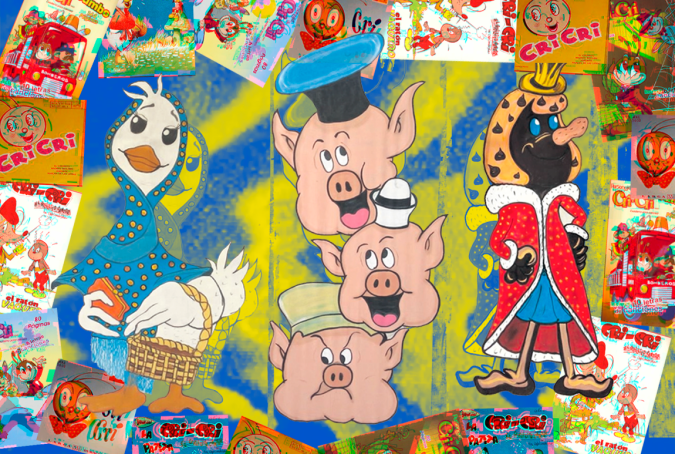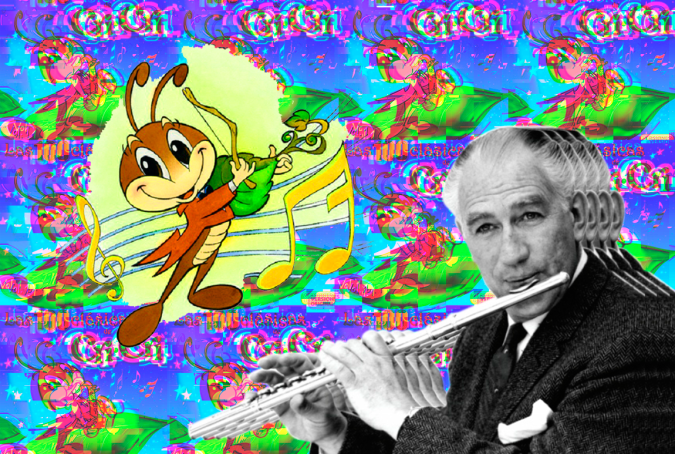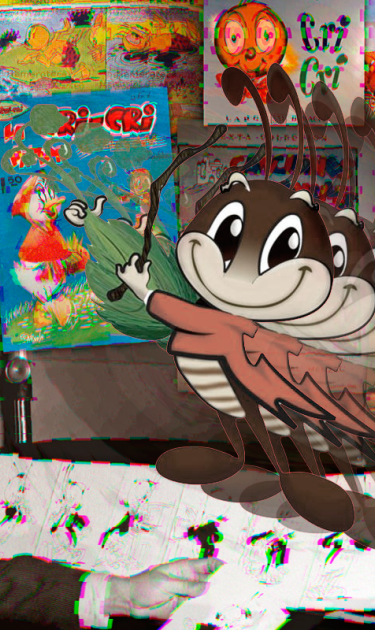A mention of the name Cri-Cri, the fictional singing cricket, might sooner draw a blank stare than an eager nod from many people under 30. Thanks to more accessible Spanish-language entertainment, Cri-Cri, once beloved by Mexican children, is now more analogous to a relic than to a cultural icon. Starting in 1934, Cri-Cri El Grillito Cantor’s music captivated the imaginations of millions of Spanish-speaking children. So ubiquitous were Cri-Cri’s songs, and later his image, that they are widely considered the soundtrack of many Mexican and Central American childhoods. For two-thirds of the 20th century, Cri-Cri helped countless parents and abuelitas lull children to sleep. And for multiple generations, Cri-Cri is the sound of innocence.
Yet, that ostensibly lighthearted purity buckles under the crushing intricacies of its past. Cri-Cri’s songs are tender and nostalgic folk lullabies, but some of these anthems harbor anti-black undertones. Cri-Cri, like most cultural artifacts of Latin America, is tethered to a hefty legacy of colonialism, illustrating perhaps more poignantly than any other character of its time how the things we held so dearly were also the things that so deeply ingrained us with colorism and disdain for the black body. That’s why it’s no surprise that the Cri-Cri character was born in Veracruz, a Mexican state with a large Afro-Mexican population.
Cri-Cri’s creator, Francisco Gabilondo Soler, was born in Orizaba, Veracruz in 1907, and taught himself to play pianola at a young age. He dropped out of school in 6th grade, opting to learn relevant subjects on his own rather than waste time in classes he rarely attended. He eventually enrolled in the National Observatory of Mexico, but had to withdraw due to lack of funding. Failed stints as a boxer, bullfighter, and typist led the aspiring crooner to focus on music, but making a living playing in the bathhouses of southern Mexico proved impossible.

Soler saw a void in children’s music and made a pivot to radio, and on October 15, 1934 debuted Cri-Cri. Inspired by the imaginative stories of Jules Verne and Hans Christian Andersen, Cri-Cri introduced the children of Mexico to characters like La Muñeca Fea, El Chorrito, La Patita, and El Rey de Chocolate.
Soler’s knack for sentimental songs that appeal to both children and adults is most evident in compositions like “Di Por Qué,”a mawkish exploration of aging via a young child who questions why his grandmother’s appearance is changing – wrinkles getting deeper, her stature diminishing, death surely nearing.
But peel just one wistful layer off, and you’re met with more troubling songs that expose some of the era’s prejudices. Take “Negrito Sandía,” about a young black boy told to stop saying “picardía” (naughty things) or he’ll be beaten. The song includes lyrics like, “Negrito Sandía/ya no diga picardía/Negrito Sandía/o te acuso con tu tía…Con el palo que utiliza/el castigo te horroriza/Y después de la paliza /me voy a morir de risa.” “‘Negrito Sandía’ is supposed to learn to keep his mouth closed, not speak out of place, or else he’ll be beaten,” says Dr. Laura G. Gutierrez, Interim Chair and Associate Professor in the Department of Mexican-American and Latina/o Studies at the University of Texas-Austin in an interview with Remezcla. “[The song] is about social control of blackness through violence.” Teaching children discipline through the physical suffering a black body – particularly one who says “naughty” or “disrespectful” things – is a disturbing concept, but it’s one that countless kids gleefully sang along to in their youth.
In “Negrito Bailarín,” the narrator invites the listener to watch a dancing black man that is kept inside of a box. “Un negrito bailarín/De bastón y con bombín…Hey amigo, lo compré/Para ve’ bailar a uste’/Perezoso mueva los pies!” go the lyrics. “¡Morenito, vamo a ve’/‘Si por fin se anima uste’/Y no baila algo de tap!” Gutierrez explains that this song traces back to Cuban theater traditions that traveled to Mexico in the 19th century, which often featured stereotypical characters such as the negrito, a dancing black man. “The black tap-dancing doll that comes out of the ‘box’ as the lyrics of the song say is but a formulation of the black dancers that became very popular in Cuba’s popular theater stages. This type of cultural entertainment was very popular nationally. Take for example the [Cuban] tradition of teatro bufo; it also traveled and influenced theatrical representations in early and mid-twentieth century Mexico. Its visual counterpart may be found in the infamous El Negrito lotería card,” Gutierrez explains. Though teatro bufo is distinct from the racist practice of blackface minstrelsy in the U.S., it does belie a specific legacy that traveled through the Caribbean to Mexico – and exemplifies how black people (and often blackface) is used for the entertainment of white(r) audiences.
Meanwhile, “La Negrita Cucurumbé,” another classic Cri-Cri number, seemingly paints blackness in a more positive light. The song’s protagonist tries to whiten herself with the ocean’s water, only to have a compassionate fish tell her she’s beautiful just as she is. “Pues que no ves? Que así negra estás bonita?” the fish sings to Cucurumbé. According to Soler’s grandson Óscar Gabilondo Vizcaíno, songs like “La Negrita Cucurumbé” were an attempt to distance Soler from the prejudiced views so many in Mexico held at the time. “[Soler] loved Veracruz and these songs were a tribute to the port city and its children,” said Gabilondo Vizcaíno in an interview with El País in 2017. “He said every boy and girl was beautiful.” Regardless of these claims, the conflicting themes of embracing blackness as a form of self-love and the threat of violence against black boys in Soler’s other songs complicate Cri-Cri’s legacy.
As time went on, American counterparts like Looney Tunes were able to simply erase or re-imagine racist characters like Mammy and Mammy Two Shoes. But Cri-Cri existed in a space free of public outcry or criticism – even to this day, there isn’t much out there about the anti-black elements of some of the cricket’s songs. Cri-Cri never grew as a brand the way Disney did, and thus never had to go back and clean up its image, though opportunities for the growth of the company existed.

Accusations that Disney plagiarized Cri-Cri for the character of Jiminy Cricket have often floated around, though Soler never commented on it. In fact, the two collaborated on a cartoon version of Cri-Cri’s “Los Tres Cochinitos Dormilones.” This brief crossover put Cri-Cri in the same league as Disney, spreading Soler’s whimsical stories about melting chocolate kings and renegade American rodents to larger audiences.
Cri-Cri’s humorously dark lyrics resonated in the living rooms of Mexico’s youth, with Soler’s own children often serving as his attentive test audience. Over the years, Soler recorded at least eight albums under the Cri-Cri moniker and released various compilations, as his fame spread across Central and South America. Cri-Cri’s music was translated to English, French, and Russian, with cover versions sung by artists like Placido Domingo and Eugenia León.
Soler fought long and hard to preserve his vision of the brand, and rejected various offers to expand or sell his enterprise. He remained steadfast in his desire to keep Cri-Cri as a legacy for Mexican children. But his resolve to keep Cri-Cri free of outside influence all but ensured its eventual demise. Without any new material keeping new generations interested, for years it was abuelitas and nostalgic parents who maintained those songs – with all of their sentimental nuance and anti-black undertones – alive. As those generations die off or are overruled by on-demand video, Cri-Cri’s stories are fading into a tender yet oft unenlightened footnote in history.




